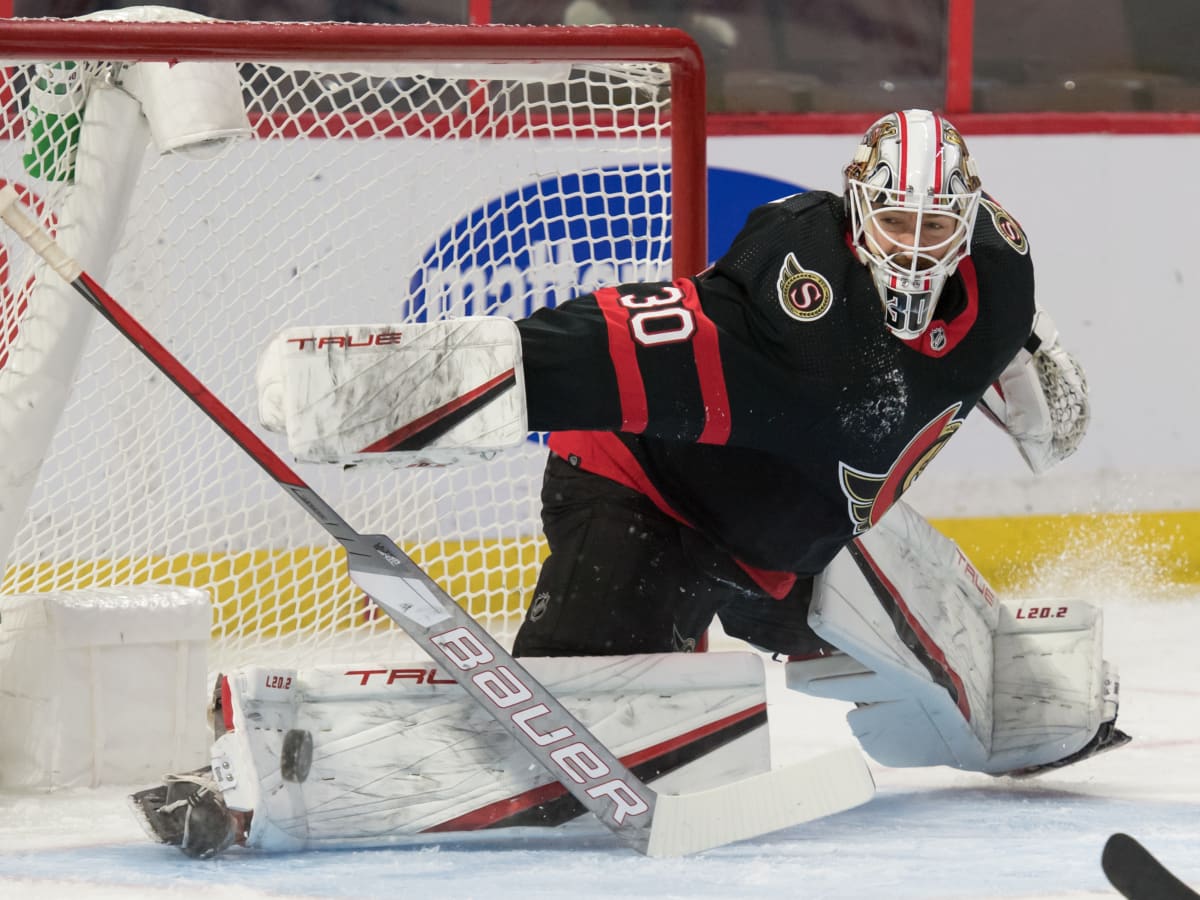There’s a good chance that Matt Murray plays for the Toronto Maple Leafs this season.
With the Ottawa Senators planning to go forward with a tandem of Anton Forsberg and Filip Gustavsson, trading Murray would free up some spending money ahead of free agency. We know that Murray turned down a trade to Buffalo that would have sent the seventh-overall pick (along with 25% retention) to the Sabres in exchange for the 16th pick, so it’s clear that Ottawa is quite motivated to move this player. In case you missed it, Elliotte Friedman has reported that the Leafs have now “intensified discussions” to acquire him.
https://twitter.com/FriedgeHNIC/status/1546195439036284928
Murray was not on my initial list of offseason targets. The Leafs still had Petr Mrazek at the time, and Murray seemed like a goaltender with a similar story of recent injuries and ineffectiveness. However, the more I look into Murray, the more I like the idea of acquiring him. The Leafs would need significant salary retention in order to make the cap hit work, but that shouldn’t be a problem. I won’t be satisfied if Erik Kallgren is the other option, but I do believe that taking a chance on Murray makes a fair amount of sense.
Let’s start by getting to know Murray’s career.
The Early Success of Matt Murray
Murray was a third-round pick of the Penguins back in 2012. He struggled in his first year after the draft with the Soo Greyhounds, but he broke out in a big way in his final season there. He was then spectacular in his first professional season with the Wilkes-Barre/Scranton Penguins of the AHL, posting a .941 (!) save percentage (SV%) in 40 games.
He picked up right where he left off in his second AHL season, posting a .931 SV% in 31 games before earning a callup to Pittsburgh. He was an immediate star in the NHL, where he posted a .930 SV%. in 13 regular-season games before leading his team to the Stanley Cup with a .923 SV% in 21 playoff games.
Just when you thought things couldn’t get any better, things got better. He posted a .923 SV% in 49 games in his first full NHL season and then excelled to the tune of a .937 SV% in 11 playoff games on the way to another Stanley Cup championship. With early success that was frankly unheard of for such a young goaltender, Murray was widely regarded as one of the game’s best.
His third season with the Penguins was fine but not spectacular (.907 SV% in 49 games), but he bounced back as a high-end starter in 2018-19 (.919 SV% in 50 games). Up until this point, there was little doubt that Murray was a quality starting netminder. It’s been the last three seasons that have left everyone with major questions.
Murray’s Two-Year Decline
Murray’s numbers drastically fell in the 2019-20 season. He started the season off fine, with slightly above average numbers (by GSAx) over his team’s first 11 games. He then experienced an 11-game stretch where he seemingly forgot how to stop a puck, but his numbers returned to around league average over his final 16 games. All in all, he ended up with a .899 SV% in 38 games that season, which didn’t exactly inspire confidence.
The Ottawa Senators took a big bet that he would bounce back to his old self by trading a second-round pick and prospect Jonathan Gruden for him before signing him to a four-year, $25 million deal two days later. Unfortunately for them, he didn’t bounce back whatsoever, posting an .893 Sv% in 27 games while dealing with various injuries.
It’s tough to know how much of his 2020-21 struggles were due to injury. In a season that started in mid-January, he was injured for part of February, March, and April:
DJ Smith – Matt Murray wont play tomorrow. Upper Body Injury. Hogberg will start and Gustavsson will back up. We will re-evaluate after tomorrow’s game see where we go from there.
— TSN 1200 (@TSN1200) February 12, 2021
DJ Smith with injury updates on Sens players:
Joey Daccord: “Will be out for a little bit”. Still waiting on official diagnosis.
Colin White: Day-to-day with an upper body injury.
Matt Murray: Day-to-day with an upper body injury
Evgenii Dadonov: Maintenance day
— Ian Mendes (@ian_mendes) March 18, 2021
Matt Murray is out with a lower body injury. @Senators
— Renaud Lavoie (@renlavoietva) April 25, 2021
It seemed like everything that could have gone wrong in his first season in Ottawa went wrong. We’ll never know how many of those games he played at close to 100%, but he wasn’t exactly getting the benefit of the doubt from Sens fans given that he had also struggled with the Penguins the previous season.
Despite the fact that he was a 27-year-old with plenty of early career success, Murray’s contract sure seemed to be completely immovable last offseason.
Murray’s Bounce-Back 2021-2022 Season
Murray’s started his second season in Ottawa quite well with back-to-back strong performances against San Jose and New York. Unfortunately, he briefly headed to the IR with a head/neck injury and then got pummelled for five goals against Chicago in his first game back. He played two more games against Tampa Bay and Boston followed by a pretty rough bout with Covid.
After his first game back from illness didn’t go well, he was sent to the AHL a few days later to “find his game.” Whatever happened down there sure seemed to work; he returned to the NHL in January and proceeded to dominate for two months. In 12 games in January and February, he posted a .932 SV% with a whopping 13.78 GSAx. He was one of the best stories in the league by the end of February:
Quietly, Matt Murray now has a better save percentage than these goalies:
Jack Campbell
Darcy Kuemper
Sergei Bobrovsky
Connor Hellebuyck
Jonathan Quick
Marc-Andre Fleury
Carter Hart
Linus Ullmark
John Gibson
Robin Lehner
Alex Nedeljkovic#GoSensGo #HockeyTwitter— Naftali Clinton (@NaftaliClinton) February 27, 2022
If the season ended on February 28th, the Sens probably wouldn’t be trying to trade Murray. Despite his early-season struggles, he would have finished with a .920 SV%. On a per-minute basis, his GSAx would have finished fourth in the league behind only Igor Shesterkin, Frederik Andersen, and Eric Comrie. He wasn’t just good for two months — he was spectacular.
The final two games of his season hurt his numbers drastically. He allowed five goals on 22 shots against Tampa, although I don’t even think he played that poorly. Nikita Kucherov scored a beauty, Brayden Point beat him short-side, Steven Stamkos scored a signature power-play one-timer, Corey Perry chipped one in after the puck deflected back off the boards, and Mikhail Sergachev sniped one off the post and in. Maybe you’d like him to have one out of the five, but I wouldn’t say that he was completely horrendous. It was his first bad game (-0.5 GSAx or worse) in ages, and nobody would have thought anything of it if a disaster game didn’t follow.
His final game of the season against Arizona crushed his trade value. He allowed eight goals on 31 shots and his save percentage fell from .915 to .906 in one evening. He went from the NHL’s sixth-best goaltender by GSAx per minute (and that’s with a bad start to the season) to above-average but not spectacular. He also ended up leaving the game with a concussion.
It wasn’t his best game of the season, but I don’t think he was that bad. It’s unusual for a goaltender to be left in for eight goals against, but typically, there’s some damage control to a goalie’s numbers when they “don’t have it that day.” Let’s go through the eight goals:
- A point shot was blocked, and no one knew where it was. Nick Schmaltz found it first and beat Murray with a nice backhand. This wasn’t a bad goal against.
- Murray made a nice save but kicked out a big rebound. Shayne Gostisbehere made everyone think that he was going to shoot and then fired a great pass. The goal itself was nice, but you can critique the initial rebound.
- After the Sens made a terrible turnover in their own end, Nick Schmaltz converted on a quick breakaway. Murray was playing rather fine to this point.
- Murray made a nice save off of Kessel, but the rebound went right to Matias Maccelli, who no Sens player has covered. Murray might’ve wanted to have this one back, but it was not terrible.
- This one was 100% on Murray, who went back to play the puck and botched it. He had no chance on the resulting shot, but he caused the goal against.
- This was a really nice goal off some great passing. You can’t really blame Murray too much for this one.
- A weird deflection found its way into the net.
- Dysin Mayo was allowed to walk into the slot and fire a shot off the post and in.
Was it Murray’s best game? No. If the Leafs liked Murray as an offseason target before this game, was this enough to take him off their list completely? Also no. D.J. Smith would have almost certainly pulled him if he was as bad as his -4.09 GSAx for the night suggested. He cost his team a goal or two, but certainly not four.
Assessing Murray as a Trade Target
Murray checks a lot of boxes for me. I want both of Toronto’s goalies to have a legitimate chance to win the starter’s net; Murray certainly possesses that potential. He’s won two Cups and posted a .918 SV% in his first four seasons (161 GP). Add in a .921 SV% in 48 playoff games during that time frame, and he was one of the better goaltenders in hockey for a 200+ game stretch. There is plenty of upside if he bounces back.
Murray was also arguably the best goaltender in hockey over a recent month-and-a-half stretch. One meaningless game against the Arizona Coyotes shouldn’t change our opinion of him all that much; if that game never happens, he finishes with a .914 SV% (the same as Jack Campbell) thanks to a wicked second half. The Sens still may have had to retain 25% to move him, but they probably wouldn’t have to offer swapping the seventh-overall pick for the 16th pick to do so.
As with any trade, it all comes down to price. Like John Gibson, the first question becomes, “How much salary will they retain?” It would cost the Sens $10 million to buy him out, and they were willing to make the pick swap to save $6.25 million in actual cash (plus, it also helps their long-term cap situation). If Murray hadn’t nixed the deal, the Sabres would have him for a $4.6875 million cap hit right now. They would have received something quite valuable to take that on.
The Leafs are far more interested in cap space than future assets right now. They almost certainly aren’t taking Murray on unless they can get him for under $4 million, and it would probably need to be closer to (or even under) $3 million. The deal that makes the most sense here is a three-team trade in which Ottawa first makes a similar deal that they tried to make with Buffalo and the third team retains additional salary.
Murray isn’t worth a $4.6875 million cap hit, which is obviously why Buffalo was going to get a good asset to take him at this price. Rather than keeping him for their roster, they would retain salary in order to flip him to the Leafs. In the new scenario, the Leafs could potentially give up an asset as well in order to get even more retention.
Hypothetically, let’s say that Murray is worth a $3 million cap hit. Let’s say that the Sens do something similar to the 25% retention plus an asset trade that they were previously willing to do. The third team retains the extra $1.6875 million for no further compensation, as Murray has no surplus value at a $3 million cap hit. The Leafs can then pay for additional compensation to knock the cap hit down even further.
The tricky part of this trade is that you have to get an agreement from three teams, which takes time. The pick swap deal is no longer on the table for the Sens now that the draft has passed, so they’ll have to agree on a new way to compensate the third team. Perhaps they retain a little bit more in order to give up a little bit less.
The Leafs are in a situation where they should strongly consider paying for additional cap space, so the Leafs and the third team then need to agree on both retention and return. There are plenty of teams that can help to broker this trade, so both teams will be shopping around for the best price. Half the league probably knows about this trade by this point, which would explain why it got leaked.
Assuming the cap hit is low enough, there’s some upside with Murray and not a ton of risk. You give him a one-year tryout, and you move the last year of his contract if it doesn’t work out. His cap hit will be less than Mrazek’s was and he’ll have one year less of term, so it shouldn’t cost much at all to move him. You’ll be able to bury plenty of his cap hit if needed.
If the 2022 version of Murray is somewhat real, you might end up with a quality starter for a bargain price, just like they did with Campbell. Perhaps he goes back to struggling — either through performance or injuries — but I like the gamble if the cap hit is low enough.
I don’t think they want him because of the Soo Greyhound connection (and I think they should get a one-year pass on complaints about this after how well the Michael Bunting signing worked out). I think they want him because he’s a 28-year-old who was formerly a good starter and is coming off a great stretch of play.
I think there’s more potential here than a quick glance at his hockeydb page suggests. There’s a reason he’s cheap, but I like the gamble here. I personally didn’t realize before digging into it that Murray was so dominant towards the end of his season.
The Leafs need two goaltenders. Kyle Dubas may say publicly that he trusts Erik Kallgren and Joe Woll, but I highly doubt that’s the case. He’s definitely not going to talk to the media and say, “We have zero goalies that we trust, and we’re completely desperate to make a move. We’ll pay whatever it takes.” Keep in mind Dubas gave Petr Mrazek a vote of confidence before moving him days later.
I expect them to add Murray, and I doubt that they’ll be finished there.






























![New Leaf Anthony Stolarz on the opportunity in Toronto: “In Florida, I knew my role as a backup… Now, [Joseph Woll] and I are competing for starts… As a goalie, that’s all you can ask for” Anthony Stolarz, Stanley Cup win, now Maple Leaf](https://mapleleafshotstove.com/wp-content/uploads/2024/07/anthony-stolarz-sc-100x70.jpg)
